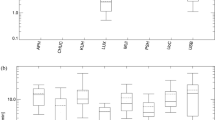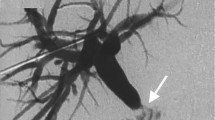Abstract
Purpose
The primary aim of this study is to provide a summary of operators’ radiation doses during hepatobiliary fluoroscopic guided procedures. In addition, patient dose in these procedures was also documented.
Materials and Methods
A total of 283 transarterial chemoembolisation (TACE) and 302 biliary procedures, including 52 percutaneous transhepatic cholangiogram (PTC), 36 bilioplasty and 214 biliary catheter changes (BCC) performed over 14 months, were included. Electronic personal dosimeters were used to measure operator radiation doses. Effective dose (E) was calculated using modified Niklason algorithm. Patient dose was measured as dose area product (DAP) and fluoroscopy time (FT).
Results
For TACE, E for radiologist ranged between 0 and 9.96 µSv, for radiographer 0–0.99 µSv and for nurse 0–4.65 µSv. The patient DAP and FT ranged between 1.5 and 421.9 Gy cm2 and 1.91–67.25 min. For PTC, E for the radiologist ranged between 0.33 and 55.89 µSv, for radiographer 0–38.61 µSv and for nurse 0–3.18 µSv. Patient DAP and FT ranged between 1.7 and 218.4 Gy cm2 and 2.07–71.53 min. For bilioplasty, E ranged between 0.09 and 9.24 µSv for radiologist, 0–0.84 µSv for radiographer and 0–1.38 µSv for nurse. The patients’ DAP and FT ranged from 0.7 to 52.54 Gy cm2 and 1.13–24.47 min. For BCC, E ranged from 0 to 12.78 µSv for radiologist, 0–8.43 µSv for radiographer and 0–4.05 µSv for nurse. Patient DAP and FT ranged between 0.12 and 117.3 Gy cm2 and 0.57–15.83 min.
Conclusions
This study shows that doses to all operators performing hepatobiliary interventional procedures can be very low.





Similar content being viewed by others
References
European Society of Radiology (ESR). Summary of the European Directive 2013/59/Euratom: essentials for health professionals in radiology. Insights Imaging. 2015;6:411–7.
Miller DL, Balter S, Cole PE, et al. Radiation doses in interventional radiology procedures: the RAD-IR Study—part I: overall measures of dose. J Vasc Interv Radiol. 2003;14:711–27.
The 2007 recommendations of the international commission on radiological protection. ICRP publication 103. Ann ICRP. 2007;37(2–4):1–332.
ICRP (2012) ICRP statement on tissue reactions/early and late effects of radiation in normal tissues and organs—threshold doses for tissue reactions in a radiation protection context. ICRP Publication 118. Ann. ICRP 41(1/2).
Finkelstein MM. Is brain cancer an occupational disease of cardiologists? Can J Cardiol. 1998;14:1385–8.
Eagan JT Jr., Jones CT. Cutaneous cancers in an interventional cardiologist: a cautionary tale. J Interv Cardiol. 2010;24:49–55.
Ciraj-Bjelac O, Rehani MM, Sim KH, Liew HB, Vano E, Kleiman NJ. Risk for radiation-induced cataract for staff in interventional cardiology: is there reason for concern? Catheter Cardiovasc Interv. 2010;76:826–34.
Shore RE, Neriishi K, Nakashima E. Epidemiological studies of cataract risk at low to moderate radiation doses: (not) seeing is believing. Radiat Res. 2010;174:889–94.
Vano E, Kleiman NJ, Duran A, Romano-Miller M, Rehani MM. Radiation-associated lens opacities in catheterization personnel: results of a survey and direct assessments. J Vasc Interv Radiol. 2013;24:197–204.
Roguin A, Goldstein J, Bar O, Goldstein JA. Brain and neck tumors among physicians performing interventional procedures. Am J Cardiol. 2013;111:1368–72 (Reviewer 5).
Siegel JA, Pennington CW, Sacks B, Welsh JS. The birth of the illegitimate linear no-threshold model: an invalid paradigm for estimating risk following low-dose radiation exposure. Am J Clin Oncol. 2015. https://doi.org/10.1097/COC.0000000000000244.
Siegel JA, Pennington CW, Sack B. Subjecting radiologic imaging to the linear no-threshold hypothesis: a non sequitur of non-trivial proportion. J Nucl Med. 2017;58:1–6.
Miraglia R, Gerasia R, Maruzzelli L, D’Amico M, Luca A. Radiation doses to operators performing transjugular intrahepatic portosystemic shunt using a flat-panel detector-based system and ultrasound guidance for portal vein targeting. Eur Radiol. 2016;27(5):1783–6.
Belanger B, Boudry J. Management of pediatric radiation dose using GE fluoroscopic equipment. Pediatr Radiol. 2006;36(Suppl 2):204–11.
Cortis K, Miraglia R, Maruzzelli L, Gerasia R, Tafaro C, Luca A. Removal of the antiscatter grid during routine biliary interventional procedures performed in a flat-panel interventional suite: preliminary data on image quality and patient radiation exposure. Cardiovasc Interv Radiol. 2014;37:1078–82.
Niklason LT, Marx MV, Chan HP. The estimation of occupational effective dose in diagnostic radiology with two dosimeters. Health Phys. 1994;67:611–5.
Dubois D, Dubois EF. A formula to estimate the approximate surface area if height and weight be known. Arch Intern Med. 1916;17:863–71.
Bova V, Miraglia R, Maruzzelli L, Vizzini GB, Luca A. Predictive factors of downstaging of hepatocellular carcinoma beyond the Milan criteria treated with intra-arterial therapies. Cardiovasc Interv Radiol. 2013;36(2):433–9.
Pietrosi G, Miraglia R, Luca A, Vizzini GB, Fili’ D, Riccardo V, D’Antoni A, Petridis I, Maruzzelli L, Biondo D, Gridelli B. Arterial chemoembolization/embolization and early complications after hepatocellular carcinoma treatment: a safe standardized protocol in selected patients with child class A and B cirrhosis. J Vasc Interv Radiol. 2009;20(7):896–902.
Kim KP, Miller DL, Berrington de Gonzalez A, et al. Occupational radiation doses to operators performing fluoroscopically-guided procedures. Health Phys. 2012;103(1):80–99.
Sailer AM, Paulis L, Vergoossen L, Kovac AO, Wijnhoven G, Willem G, Schurink H, Mees B, Das M, Wildberger J, de Haan MW, Jeukens C. Real-time patient and staff radiation dose monitoring in IR practice. Cardiovasc Interv Radiol. 2017;40:421–9.
Author information
Authors and Affiliations
Corresponding author
Ethics declarations
Conflict of interest
The authors declare that they have no conflict of interest.
Additional information
Co-First Authorship: Sarah Degiorgio and Roberta Gerasia.
Rights and permissions
About this article
Cite this article
Degiorgio, S., Gerasia, R., Liotta, F. et al. Radiation Doses to Operators in Hepatobiliary Interventional Procedures. Cardiovasc Intervent Radiol 41, 772–780 (2018). https://doi.org/10.1007/s00270-017-1870-3
Received:
Accepted:
Published:
Issue Date:
DOI: https://doi.org/10.1007/s00270-017-1870-3




